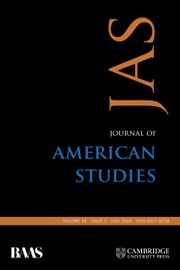In his June 2019 testimony on reparations to the United States House of Representatives, Ta-Nehisi Coates said, “It is impossible to imagine America without the inheritance of slavery.”Footnote 1 This statement, coupled with the current paroxysms of political discourse and deep divisions in American society around questions of race, identity, representation, violence, and justice, suggests that Stanley Harrold's new book American Abolitionism is both timely and prescient. It is timely since the 2019 House's consideration of HR 40 – Commission to Study and Develop Reparations Proposals for African-Americans Act (a bill introduced in every Congress since 1989) urges a thorough analysis of “(1) the role of federal and state governments in supporting the institution of slavery, (2) forms of discrimination in the public and private sectors against freed slaves and their descendants, and (3) lingering negative effects of slavery on living African-Americans and society.”Footnote 2 It is prescient since Harrold's account of abolitionism from colonial times (1688) through Reconstruction (1870) shows how partial, incremental, and fraught with difficulty the struggle to end slavery in America has been and how any accommodation or settlement over the legacy of slavery will be no different.
Harrold's history is a careful account of the multifaceted and highly contested nature of abolitionism and offers an ambitious and nuanced analysis of its different phases. His account is not a simple one, grounded in mono-causal theories of moral outrage, liberal and legal rational argumentation, or economic inevitability. Rather, he engages in a careful analysis of macro-social changes and micro-political events, opportunities, and challenges that underpin several hundred years of the social struggle to make slaves free. The book reminds me of Charles Tilly's work on Big Structures, Large Processes, Huge Comparisons (1984) and James Scott's Weapons of the Weak (1987) with its focus on everyday forms of resistance.
The period between 1688 and 1870 in America covers large processes of the American Revolution and nation building, the expansion and consolidation of the United States, patterns of different forms of economic development, and the deadliest internal conflict in American history. Within these larger processes, we learn from Harrold how a disparate and fragmented struggle for the abolition of slavery found its origins across moral, philosophical, and political arguments. How it articulated its claims using a variety of different frames. How it operated along a continuum of strategies, including violent insurrection, petitioning, lobbying, and rescuing slaves. How it engaged with what social-movement scholars call changing “political opportunity structures” across multiple points of access (emerging state and federal institutions) in mobilizing different parts of American civil society. And ultimately, how the abolition of slavery, in echoing Coates, represents an “ambiguous denouement” (155–77) whose inheritance runs through contemporary American politics.
His periodization captures the evolution of the movement and illustrates the ebb and flow of mobilization, the incremental successes and setbacks of the movement, and the contested idea of individual freedom as America becomes an independent nation-state. His chapters are rich in detail, personalities, and significant events, but his summary conclusions step away from history per se and offer a fruitful window into the complex processes involved in arguably the world's first human rights movement, the outcomes of which continue to reverberate today. As Harrold notes, after emancipation, many abolitionists “lamented that they and their colleagues had failed to end white racism” and that “effective enforcement of the Thirteenth, Fourteenth, and Fifteenth Amendments became impossible” (179). The continuation of the struggle over civil rights and equality, and the ongoing debate on reparations, suggest that their own “perception of failure” (179) has indeed been borne out by events. This book is a must-read for historians, political scientists, and social-movement scholars the world over.



